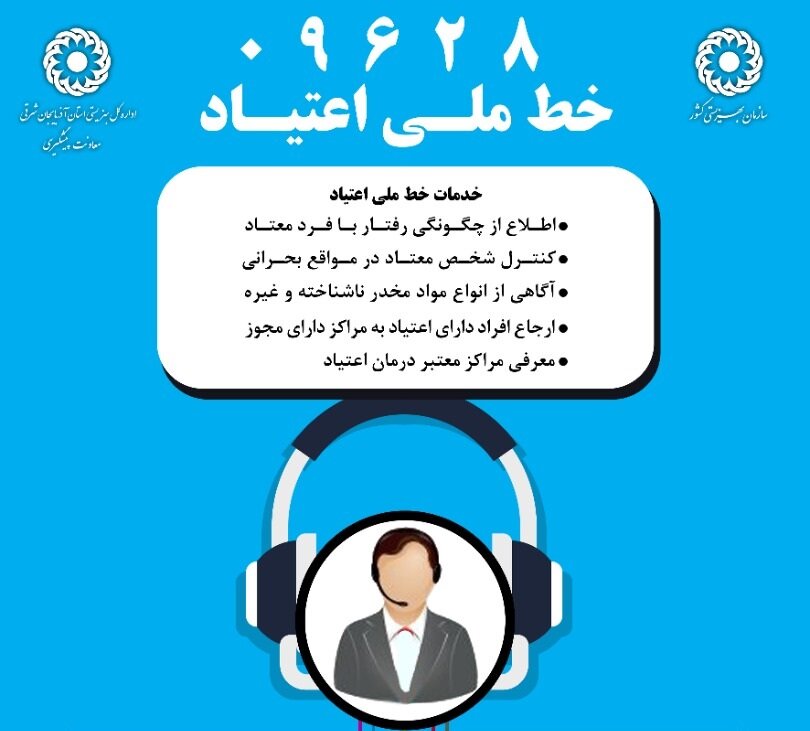They are briefly referred to:
A) Addiction prevention includes the following activities: Community-based addiction prevention program: In a participatory manner with people in urban and rural areas, educational environments with emphasis on primary school children and their families and work environments. Addiction Prevention Awareness and Media Campaign: Aimed at sensitizing people about the prevention of addictive substance use through media activities and training required in the form of educational products and training sessions. Cyber Addiction Prevention Program (Carbin): In line with this program, addiction prevention media packages are published under the title "Carbin" in cyberspace. National Addiction Line: This line is called (09628) with the aim of providing addiction prevention strategies and guidance on addiction treatment and referral to an officially licensed addiction treatment and harm reduction center. Call time is every day from 8 am to 8 pm.
B) Treatment, harm reduction and social support include a variety of activities as follows:
1) Addiction treatment and rehabilitation program Outpatient Addiction Treatment Center: An addictive substance abuse treatment center that provides daily drug and non-drug treatment services to people with a drug or psychiatric disorder. The names and addresses of the centers are available in the National Addiction Hotline System (09628). Residential Center for Recovery and Rehabilitation of People with Drug Use Disorders: It is a medical center that provides residential treatment services (including pharmaceutical and non-pharmaceutical) preferably with the participation of peer groups and self-help voluntarily for one to three months to people with drug use or psychosis. Gives. Therapeutic Community Center (TC): A residential treatment center with a behavioral and cognitive change approach and with the aim of providing treatment and rehabilitation of drug or psychiatric disorders on a 24-hour basis for at least three to six months, non-pharmacological treatment services such as psychological services, counseling Provides family education, self-help groups, social work services, and post-discharge follow-up.
2) Addiction harm reduction program: Harm reduction strategies and measures are one of the most basic strategies in the field of prevention of infectious and contagious diseases such as AIDS and hepatitis. Since these diseases are very closely related to poverty and the people affected by them are mainly from the needy and in the lower income classes and deciles, or after being infected with these diseases, they fall into the lower social groups, so comprehensive economic support , Society is a necessity for them and therefore the country's welfare organization both because of its responsibilities in the field of addiction and because of the need to support the affected and vulnerable (vulnerable) groups in the field of prevention, reduction and control HIV / AIDS and advocates for people and their families.
Harm reduction programs are implemented in the Welfare Organization to reduce the effects of drug use and prevent HIV, and the main target audience of these programs is drug users who have high-risk behaviors such as injecting drug users and homeless users in women with Behaviors are risky. Harm reduction services and programs include training, distribution of harm reduction items such as needles and syringes, condoms, etc. Overnight stay, nutrition and meal delivery, methadone maintenance treatment, social support, referral and follow-up services, rapid etch testing IV is mobile consulting and services. HIV harm reduction and prevention services are provided to the target groups in mobile van mobile centers, mobile teams, harm reduction stations and positive clubs. Training, empowerment of peer groups, providing harm reduction items, rapid (initial) HIV testing, referral, social support are among the services of the welfare organization throughout the country.
In the National Committee for Monitoring HIV Programs and the Subcommittee on Harm Reduction, the Welfare Organization is one of the main and active members, and in the Fourth Strategic Plan for Controlling HIV in the country, it has been responsible for various tasks and services. Non-governmental organizations and prevention experts have been the main partners of the Welfare Organization in the implementation of the program, so creating an active and dynamic network consisting of all stakeholders and non-governmental actors across the country under the guidance of the Welfare Organization can be a vision. Have clarity in formulating and implementing harm reduction programs as well as the fifth strategic plan for HIV control in the next 5 years.
Service Provider Units Injury reduction programs are offered according to the needs and specifications of the area and evaluations performed in various units, which are: Transit Center (DIC), Night Shelter Center (Shelter), Passage Center / Night Shelter (DIC / shelter), Team Outreach, Mobile Center, Injury Reduction Station. Transition Center (DIC): In order to control or reduce high-risk behaviors, the center provides harm reduction services (healthy injection and healthy sexual behavior training, needle delivery) to people with substance abuse problems and hard-to-reach addicts who do not visit treatment centers. Offers syringes, condoms, food, clothing and bathing). These centers are daily and provide services 4 to 6 hours a day. In 26 provinces, there are 96 men's transit centers and 12 women's transit centers in 9 provinces


Your Comment